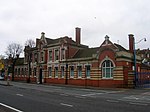Round Hill (sometimes spelt Roundhill) is an inner suburban area of Brighton, part of the coastal city of Brighton and Hove in England. The area contains a mix of privately owned and privately rented terraced housing, much of which has been converted for multiple occupancies, and small-scale commercial development. It was developed mostly in the late 19th century on an area of high land overlooking central Brighton and with good views in all directions, the area became a desirable middle-class suburb—particularly the large terraced houses of Roundhill Crescent and Richmond Road, and the exclusive Park Crescent—and within a few decades the whole of the hill had been built up with smaller terraces and some large villas.
Non-residential buildings include the landmark St Martin's Church, Brighton's largest place of worship, with its dramatically extravagant interior; the Brighton Forum, a Gothic Revival former college now in commercial use; Brighton's main fire station; and the oldest working cinema in Britain. The first hospital in England catering for mental illness was established in a house in Roundhill Crescent in 1905. Brighton's first Jewish cemetery, although a short distance outside Round Hill according to Brighton & Hove City Council's definition, has been associated with the suburb throughout its near 200-year history. The London Road viaduct, a distinctive, sweeping piece of railway architecture, forms the northern boundary of the area and "a literal gateway" between outer and inner suburbia. All of these buildings have been listed by English Heritage for their architectural and historical importance, and the core of Round Hill, around Roundhill Crescent, is one of 34 conservation areas in the city. Round Hill's steep slopes and road layout encouraged the introduction of another feature which gives the area its character: the "cat's-creep" staircase. The area has good tree cover and increasingly heavy traffic along the three main roads which run through the area.
Past features of Round Hill include a windmill, which took advantage of the windy conditions on the 223-foot (68 m) hilltop until 1913; 19th-century laundries, which sought the same advantage; early 19th-century pleasure gardens, now occupied by the houses of Park Crescent; the landmark Cox's Pill Factory, demolished in the 1980s; glasshouses and smallholdings, some of which survived until after the Second World War despite being surrounded by houses; and the Kemp Town branch line, a passenger and freight railway which cut through the area and had a short-lived station serving Round Hill. The former St Saviour's Church survived until 1983, and a Congregational church elsewhere in the suburb closed but retained its façade after its conversion into housing.








